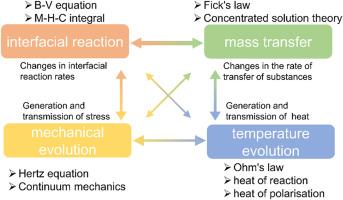Behavioral description of lithium-ion batteries by multiphysics modeling
引用次数: 0
Abstract
Upgrades to power systems and the rapid growth of electric vehicles significantly heighten the importance of lithium-ion batteries (LiBs) in energy systems. As a complex dynamic system, the charging and discharging process of LiBs involves the evolution of multiphysics fields, such as concentration, electricity, and stress. For quantitative analysis of the internal mechanisms of LiBs, as well as the development guidance and performance prediction of high-performance batteries, modeling has advantages that cannot be matched by traditional experimental methods. Major research efforts in the past decades have made significant strides in modeling the internal processes and physical field evolution of LiBs. Importantly, the scattered ideas need to be integrated into a structured framework to form a complete LiBs multi-physical field model. This work reviews important advances in LiBs modeling from the perspectives of describing the internal processes of the battery and portraying the evolution of the physical field. First, quantitative descriptions of the charging and discharging behaviors and the side reactions are reviewed to investigate the battery reaction mechanisms. In addition, the characterization of the evolution of the stress and temperature fields within the battery as well as the coupling between them and the internal reactions are discussed. Finally, some suggestions for future improvements in the modeling are given, ranging from equation optimization to parameter acquisition and the application of artificial intelligence. It is hoped that this work will facilitate the development of models with sufficient accuracy and efficient computational cost to provide guidance for the improvement of LiBs.

通过多物理场建模对锂离子电池进行行为描述
电力系统的升级和电动汽车的快速发展大大提高了锂离子电池(LiBs)在能源系统中的重要性。作为一个复杂的动态系统,锂电池的充放电过程涉及浓度、电量和应力等多物理场的演变。对于锂电池内部机理的定量分析,以及高性能电池的开发指导和性能预测,建模具有传统实验方法无法比拟的优势。过去几十年的主要研究工作在锂电池内部过程和物理场演化的建模方面取得了重大进展。重要的是,需要将分散的想法整合到一个结构化框架中,以形成完整的锂电池多物理场模型。本研究从描述电池内部过程和描绘物理场演变的角度,回顾了锂电池建模的重要进展。首先,回顾了充放电行为和副反应的定量描述,以研究电池反应机制。此外,还讨论了电池内部应力场和温度场的演变特征,以及它们与内部反应之间的耦合。最后,还对建模的未来改进提出了一些建议,包括方程优化、参数采集和人工智能应用等。希望这项工作能促进开发具有足够准确性和高效计算成本的模型,为改进锂电池提供指导。
本文章由计算机程序翻译,如有差异,请以英文原文为准。
求助全文
约1分钟内获得全文
求助全文

 求助内容:
求助内容: 应助结果提醒方式:
应助结果提醒方式:


